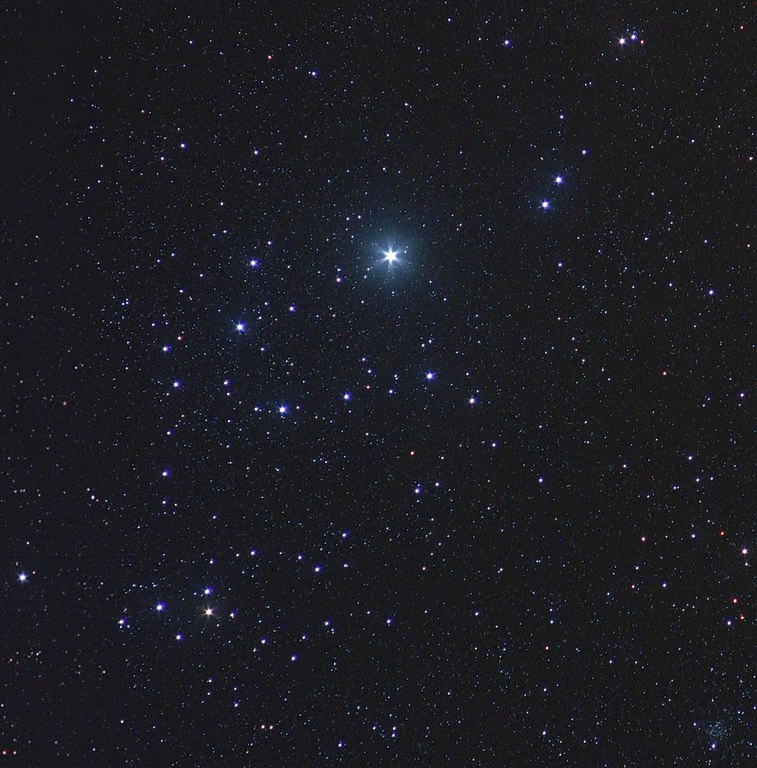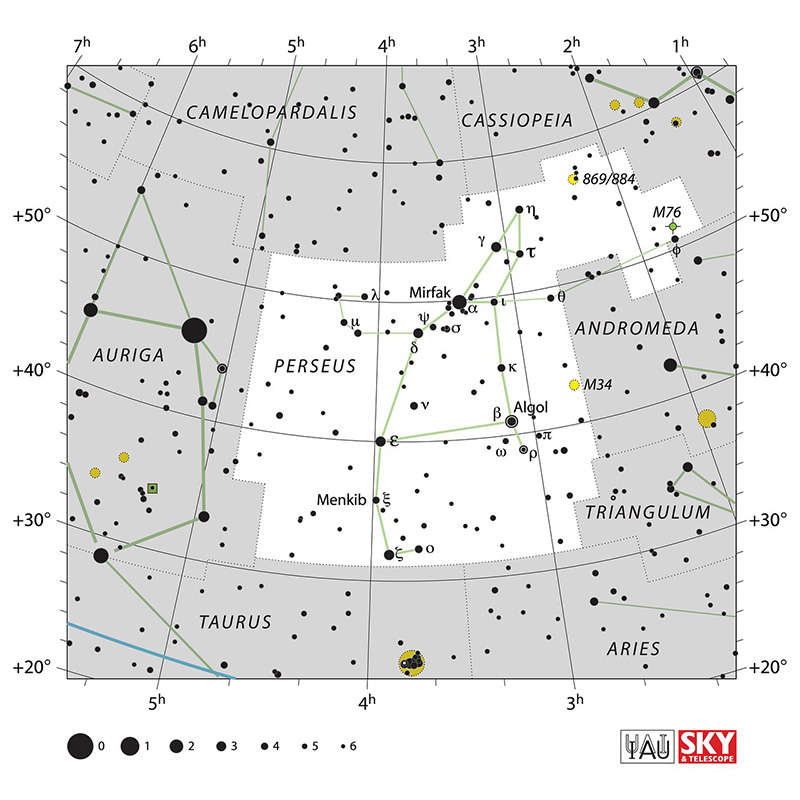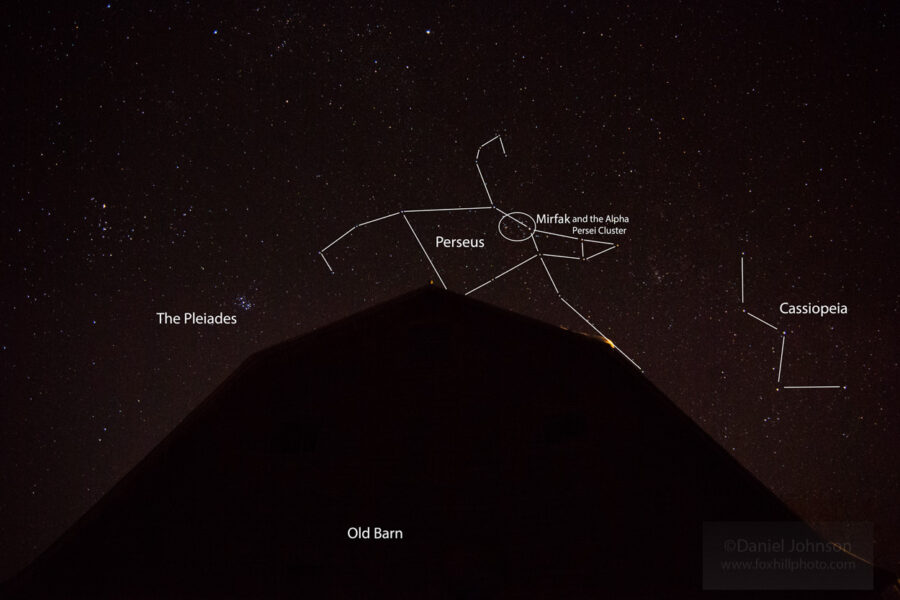| Official name | Mirfak |
| Other designations | Alpha Persei, HR 1017, HIP 15863, HD 20902 |
| Nicknames | - |
| Apparent magnitude | 1.82 |
| Distance from Earth | 506 light-years |
| Type | F5Ib (supergiant) |
| Color | Yellow/white |
| Mass | 8.5 M☉ |
| Radius | 68 R☉ |
| Constellation | Perseus |
| Right ascension | 03h 24m 19s |
| Declination | 49° 51' 40” |
| Multiple system? | No |
| Variable star? | Yes (but variations are small) |
| Exoplanets status | Possible but unconfirmed |
| Probable fate | Uncertain |
Physical Characteristics
Mirfak, the prime member of the Alpha Persei cluster, is an F-class supergiant star about 65 times bigger than the Sun. Before it began running low on hydrogen in its core — expanding and cooling into the yellow-white behemoth it is today — Mirfak was likely a smaller, hotter B-class star, like others in its cluster.

Martin Gembec
Mirfak’s mass creates an interesting question: What is the star’s endgame when the giant finally uses up its nuclear fuel? The eventual fates of stars depend entirely on each object’s mass, with a figure about 8 solar masses representing the tipping point at which a star eventually goes supernova, ending its life in a spectacular, element-seeding explosion. Stars below about 8 solar masses fade out more quietly, blowing out planetary nebulae as they shrink down to white dwarfs. Mirfak, though, sits right about the critical 8-solar-mass level, and astronomers haven’t yet nailed down the mass to the necessary prevision to decide its fate.
Swimming through space around Mirfak is a school of hot blue stars, the Alpha Persei Moving Cluster (Melotte 20). They were born together and move through space tied together by their gravity. The region is thus a rich place to explore with binoculars or a small telescope.
Mirfak is technically a variable star showing changes in brightness over time, but this variability is quite minor. For practical purposes, Mirfak can be thought of as a reliably steady star, contrasting nicely with its nearby companion Algol, one of the most recognizable variable stars with regular, obvious brightness swings.
Finally — and perhaps most interestingly — Mirfak just might be the host of at least one exoplanet. But knowing for sure is a tricky proposition. The radial velocity method, which involves a careful measurement of the star's wobbles, hints at a planet orbiting the star. As the candidate exoplanet circles the star, the slight gravitation pull between the two bodies results in small alternating red- and blueshifts in the star's spectrum. But those same shifts could also be the result of naturally occurring pulsations in Mirfak. The exoplanet is still plausible, but unconfirmed by any other method.
Origin / Mythology
Mirfak lies in the constellation Perseus, the Hero. This constellation is a major player in a complex Greek tale involving multiple nearby constellations: Andromeda, Cassiopeia, Pegasus, Cetus, and Cepheus. In short, Perseus, the story’s brave and shrewd hero, performs a daring rescue to save Andromeda (daughter of Cepheus and Cassiopeia) from a whale-like sea monster named Cetus. In at least some versions of the story, Perseus performs the rescue with the help of the winged equine Pegasus. In the end, the thankful Andromeda marries Perseus and the two become the ancestors of the Persians.

Other stories exist for this region, too. While Mirfak is the brightest member of Perseus, its name has nothing to do with the constellation or its mythology. Instead, like so many other stars, it’s an Arabic name welded onto a Greco-Roman myth. The name Mirfak comes from a longer Arabic phrase meaning “the elbow of the Pleiades,” and indicates an even older image seen in this and neighboring stars.
How to See Mirfak
As vibrant as Perseus might have been, his constellation is somewhat dim. Mirfak stands out brilliantly, but still, if you’ve never yet gone searching for the faint celestial hero before, a couple of celestial stepping stones can point you in the right direction.

The first step is to look north. For all latitudes north of about 41°N (roughly the latitude of New York City and Salt Lake City), Mirfak is circumpolar and never sets. But even if you’re a good deal further south than that, Mirfak is close enough to the north celestial pole that it stays up most of the night any time of year. Once you’re looking northward, Cassiopeia with its easy-to-find W shape can easily get you into the right general region. Then find the Pleiades. Mirfak is roughly halfway between the two, though offset slightly toward the north. You can also use the second-from-the-left segment of Cassiopeia’s “W” to point the way.
Mirfak and Perseus lie in the center of the Milky Way plane but at the rather weaker, northern end. Even though the view lacks the spectacular dust lanes of the galactic core, there are a phenomenally large number of stars in this region, and this is quite exciting to explore with binoculars or a telescope at low power. Take a moment to appreciate what you’re seeing — the Perseus Arm of the Milky Way Galaxy.
The Alpha Persei Cluster offers an excellent opportunity to grab your binoculars and head outside for some simple and fun astronomy. You can examine this cluster with a telescope of course, but the wide view and brightness of binoculars are ideal for observing this cluster, giving you the freedom to move around quickly and really feel like you’re there. The cluster stars are all moving in the same direction, with yellowish Mirfak standing alone as the single giant of the group.
Daniel Johnson is a Wisconsin-based freelance writer and professional photographer and the co-author of over a dozen books. He’s a longtime amateur astronomer and fortunate enough to live in a rural region with excellent seeing conditions. You can view some of Dan’s photography (he does a lot of animals!) at foxhillphoto.com.
 0
0









Comments
You must be logged in to post a comment.